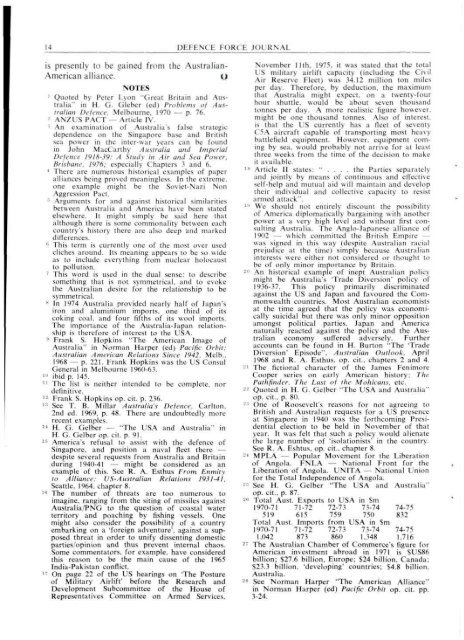ISSUE 3 : Mar/Apr - 1977 - Australian Defence Force Journal
ISSUE 3 : Mar/Apr - 1977 - Australian Defence Force Journal
ISSUE 3 : Mar/Apr - 1977 - Australian Defence Force Journal
Create successful ePaper yourself
Turn your PDF publications into a flip-book with our unique Google optimized e-Paper software.
14 DEFENCE FORCE JOURNALis presently to be gained from the <strong>Australian</strong>-American alliance.QNOTES1 Quoted by Peter Lyon "Great Britain and Australia''in H. G. Cileber (ed) Problems of <strong>Australian</strong><strong>Defence</strong>, Melbourne, 1970 — p. 76.\\/l S l'A( 1 \rticle l\•' An examination of Australia's false strategicdependence on the Singapore base and Britishsea power in the inter-war years can be foundin John MacCarthy Australia and Imperial<strong>Defence</strong> 1918-19: A Study in Air and Sea Power,Brisbane, 1976; especially Chapters 3 and 6.1 There are numerous historical examples of paperalliances being prosed meaningless. In the extreme.one example might be the Soviet-Nazi NonAggression Pact.' Arguments for and against historical similaritiesbetween Australia and America have been statedelsewhere. It might simply be said here thatalthough there is some commonality between eachcountry's history there are also deep and markeddifferences.'• This term is currently one of the most over usedcliches around. Its meaning appears to be so wideas to include everything from nuclear holocaustto pollution.7 This word is used in the dual sense: to describesomething that is not symmetrical, and to evokethe <strong>Australian</strong> desire for the relationship to besymmetrical.1In 1974 Australia provided nearly half of Japan'siron and aluminium imports, one third of itscoking coal, and four fifths of its wool imports.The importance of the Australia-Japan relationshipis therefore of interest to the USA.: ' Frank S. Hopkins "The American Image ofAustralia" in Norman Harper (ed) Pacific Orbit:<strong>Australian</strong> American Relations Since 1942, Melb..1968 — p. 221. Frank Hopkins was the US ConsulGeneral in Melbourne 1960-6?." ibid p. 145.11The list is neither intended to be complete, nordefinitive.12Frank S. Hopkins op. cit. p. 236.11 See T. B. Millar Australia's <strong>Defence</strong>, Carlton.2nd ed. 1969. p. 48. There are undoubtedly morerecent examples.« H. G. Gelber — "The USA and Australia" inH. G. Gelber op. cit. p. 91.11America's refusal to assist with the defence ofSingapore, and position a naval fleet there —despite several requests from Australia and Britainduring 1940-41 — might be considered as anexample of this. See R. A. Esthus From Enmityto Alliance: US-<strong>Australian</strong> Relations 1911-41,Seattle. 1964. chapter 8." ; The number of threats are too numerous toimagine, ranging from the siting of missiles againstAustralia TNG to the question of coastal waterterritory and poaching by fishing vessels. Onemight also consider the possibility of a countryembarking on a 'foreign adventure', against a supposedthreat in order to unify dissenting domesticparties opinion and thus prevent internal chaos.Some commentators, for example, have consideredthis reason to be the main cause of the 1965India-Pakistan conflict.17On page 22 of the US hearings on 'The Postureof Military Airlift' before the Research andDevelopment Subcommittee of the House ofRepresentatives Committee on Armed Services.November 11th, 1975. it was stated that the totalUS military airlift capacity (including the (nilAir Reserve Fleet) was 34.12 million ton milesper day. Therefore, by deduction, the maximumthat Australia might expect, on a twenty-fourhour shuttle, would be about seven thousandtonnes per day. A more realistic figure however,might be one thousand tonnes. Also of interest,is that the US currently has a fleet of seventyC5A aircraft capable of transporting most heavybattlefield equipment. However, equipment comingby sea. would probably not arrive for at least[luce weeks from the lime of the decision to makeit available.1S Article II states: " .... the Parties separatelyand jointly by means of continuous and effectiveself-help and mutual aid will maintain and developtheir individual and collective capacity to resistarmed attack".19We should not entirely discount the possibilityof America diplomatically bargaining with anotherpower at a very high level and without first consultingAustralia. The Anglo-Japanese alliance of1902 — which committed the British Empire —was signed in this way (despite <strong>Australian</strong> racialprejudice at the time) simply because <strong>Australian</strong>interests were either not considered or thought tobe of only minor importance by Britain.20An historical example of inept <strong>Australian</strong> policymight be Australia's 'Trade Diversion' policy of1436-37. This policy primarily discriminatedagainst the US and Japan and favoured the Commonwealthcountries. Most <strong>Australian</strong> economistsat the time agreed that the policy was economicallysuicidal but there was only minor oppositionamongst political parties. Japan and Americanaturally reacted against the policy and the <strong>Australian</strong>economy suffered adversely. Furtheraccounts can be found in H. Burton "The TradeDiversion' Episode". <strong>Australian</strong> Outlook. <strong>Apr</strong>il1%8 and R. A. Esthus. op. cit.. chapters 2 and 4.-' The fictional character of the James FenimoreCooper series on early American history: ThePathfinder, The Last of the Mohicans, etc.22Quoted in H. G. Gelber "The USA and Australia "op. cit.. p. 80.One of Roosevelt's reasons for not agreeing toBritish and <strong>Australian</strong> requests for a US presenceat Singapore in 1940 was the forthcoming Presidentialelection to be held in November of thatyear. It was felt that such a policy would alienatethe large number of 'isolationists' in the country.See R. A. Eshtus. op. cit.. chapter 8.21MPLA — Popular Movement for the Liberationof Angola. FN LA — National Front for theLiberation of Angola. UNITA — National Unionfor the Total Independence of Angola." See H. G. Gelber "The USA and Australia"op. cit.. p. 87.-•'• Total Aust. Exports to USA in $m1970-71 71-72 72-73 73-74 74-75519 615 759 750 832Total Aust. Imports from USA in Sm1970-71 71-72 72-73 73-74 74-751.042 873 860 1.348 1.71627The <strong>Australian</strong> Chamber of Commerces figure forAmerican investment abroad in 1971 is SUS86billion; S27.6 billion. Europe; S24 billion. Canada:$23.3 billion, 'developing' countries; S4.8 billion.Australia.25See Norman Harper "The American Alliance"in Norman Harper (ed) Pacific Orbit op. cit. pp.3-24.
















